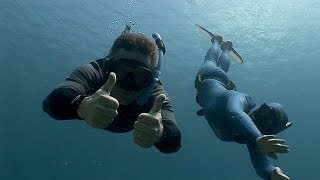Hi, I'm Jonathan Bird and welcome to my world!
嗨,我是乔纳森·伯德,欢迎来到我的世界!
Divers love warm, clear water.
潜水者喜欢温暖、清澈的水域。
And one of the most well-known locations for relaxed tropical scuba diving is the island of Bonaire.
热带潜水最著名的地方之一是博内尔岛。
Bonaire is located in the southern Caribbean, not far from the coast of Venezuela.
博内尔岛位于加勒比海南端,离委内瑞拉海岸不远。
It's a beautiful, sunny island, which enjoys sea breezes powerful enough to generate electricity, and has a long history of making salt from the ocean.
这是一个阳光明媚的美丽岛屿,享受着强到足以发电的海风,这里还有着海水制盐的悠久历史。
The last time I visited Bonaire, I was on a mission to film spawning coral.
上次我去博内尔岛时,任务是拍摄珊瑚产卵。
But this time I'll be doing some diving without a scuba tank.
但这次我要去潜水,不带氧气瓶。
Diving without scuba gear is called freediving, and frankly I'm not that good at it.
不带装备潜水叫自由潜水,坦白地说,我不擅长这个。
I've been invited to a freediving class at Buddy Dive Resort.
我被邀请到巴迪潜水胜地参加自由潜水课程。
It's being taught by Karol Meyer, a world-champion freediver from Brazil.
来自巴西的世界自由潜水者冠军卡罗尔·迈耶教授这门课程。
She can hold her breath for over 18 minutes!
她能屏吸超过18分钟!
I head down to the pool where Karol is practicing static apnea—which means holding your breath while you lie very still.
我去到游泳池,卡罗尔在那练习静态屏气,你要做的是静静地躺着,屏住呼吸。
We can start the class as soon as she comes back up from this breath.
她这口气憋完,我们就能开始上课了。
I'll be back!
我待会回来!
Wow, that took longer than I was expecting!
哇,比我预想的时间要长!
Now we can head on over to the classroom.
现在我们可以去教室了。
Karol discusses techniques for breathing, rescue techniques and of course, safety.
卡罗尔讨论了呼吸术、救援术,当然还有安全性的问题。
Next, Karol gives me some tips on breathing with my belly in order to get more air into my lungs.
接下来,卡罗尔给我提出一些有关腹部呼吸的建议,以便让更多空气进入肺部。
All my life I have been breathing, and I thought I was doing it well.
我一辈子都在呼吸,感觉自己做得很好。

But it turns out I'm doing it all wrong for freediving!
但事实证明,我做自由潜水时都错了!
Since freedivers have been known to black out if they try to hold their breath a little too long,
自由潜水员都知道,如果他们屏吸过久,就会昏厥。
the class practices rescue techniques—how to hold someone with their head above the water and open the airway to make sure they breathe.
这门课程练习了营救技术,如何使某人的头部保持在水面以上,并打开气道确保他们能够呼吸。
First Karol demonstrates, then the students try.
卡罗尔先示范,然后学生们再尝试。
You are definitely going to drown, I'm sorry.
对不起,你肯定会淹死的。
After a few attempts I get the hang of it…mostly.
试了几次后,我掌握了窍门......大部分吧。
I'm kind of hoping I don't have to rescue anyone!
我希望不用去营救任何人!
Finally we practice static apnea.
我们最后练习静态屏气。
We relax, take big breaths and float quietly face down in the pool.
我们放松、深呼吸,脸朝下、静静地漂在泳池里。
Nobody in our group is going to set a record, but we are trying to see how long we can comfortably hold our breaths.
小组中没人会创记录,但我们在看能舒服地屏吸多长时间。
I'm not wearing a mask because water on the face triggers what is called the mammalian diving response—a lowering of heart rate and conservation of oxygen.
我没有戴面罩,因为脸上的水会引发哺乳动物的潜水反应,即心率降低,以及保存氧气。
The water on my face literally helps me hold me breath longer.
我脸上的水真能帮助我屏吸到更长的时间。
After a few attempts, I manage to go just shy of three full minutes without a breath!
经过几次尝试,我终于能屏息待三分钟了!
I have never held my breath that long.
我从来没有屏吸这么久过。
That's all fine and good, but static apnea is a lot different from swimming in the ocean.
一切都很好,但静态屏气和在大海里游泳区别很大。
Karol takes the class out onto the reef to practice freediving.
卡罗尔带着全班学生到暗礁水域练习自由潜水。
We gather around a float with a line going down into the blue.
我们聚集在一个漂浮物周围,它上面有一根绳沉入海中。
One at a time, Karol takes each of us down.
卡罗尔每次带一个人下沉。
We go only to a predetermined depth so nobody gets in trouble, or has a problem getting back to the surface.
我们只到达预定的深度,所以没人会遇到麻烦,或是没法回到海面。











